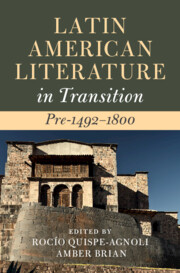Book contents
- Latin American Literature in Transition Pre-1492–1800
- Latin American Literature in Transition
- Latin American Literature in Transition Pre-1492–1800
- Copyright page
- Dedication
- Contents
- Figures
- Contributors
- Acknowledgments
- Introduction Dwelling in Transitions
- Part I Land, Space, Territory
- Part II Body
- Part III Belief Systems
- Chapter 9 The Flood Story in the Huarochirí Manuscript and Other Early Colonial Andean Texts
- Chapter 10 Idol or Martyr: Sacredness and Symbol in the Religiosity of the Indies
- Chapter 11 Creole Religiosity in Colonial Mexico: Devotional Cultures in Transition
- Chapter 12 The Empire Beyond Spanish America: Spanish Augustinians in the Pacific World, 1680–1724
- Chapter 13 Indigenous Peoples and Catholicism in Eighteenth-Century Mexico City
- Part IV Literacies
- Part V Languages
- Part VI Identities
- Index
- References
Chapter 11 - Creole Religiosity in Colonial Mexico: Devotional Cultures in Transition
from Part III - Belief Systems
Published online by Cambridge University Press: 25 November 2022
- Latin American Literature in Transition Pre-1492–1800
- Latin American Literature in Transition
- Latin American Literature in Transition Pre-1492–1800
- Copyright page
- Dedication
- Contents
- Figures
- Contributors
- Acknowledgments
- Introduction Dwelling in Transitions
- Part I Land, Space, Territory
- Part II Body
- Part III Belief Systems
- Chapter 9 The Flood Story in the Huarochirí Manuscript and Other Early Colonial Andean Texts
- Chapter 10 Idol or Martyr: Sacredness and Symbol in the Religiosity of the Indies
- Chapter 11 Creole Religiosity in Colonial Mexico: Devotional Cultures in Transition
- Chapter 12 The Empire Beyond Spanish America: Spanish Augustinians in the Pacific World, 1680–1724
- Chapter 13 Indigenous Peoples and Catholicism in Eighteenth-Century Mexico City
- Part IV Literacies
- Part V Languages
- Part VI Identities
- Index
- References
Summary
This essay examines the textual representation of creole religiosity as it developed in the sixteenth and seventeenth centuries during its transition from a transplanted, transatlantic belief system into a hybrid American faith. Various textual genres attest to this Creole faith in transition including spiritual life writings, chronicles of religious orders, sermons and tracts dealing with miracles and portents, as well as more formal literary genres including theater and poetry. Creole religiosity was a highly gendered phenomenon, and these texts reveal the contours of the exemplarity the Church demanded from men and women as well as the challenges launched against these ideals. Authors studied here include the canonical like Sor Juana Inés de la Cruz and Carlos de Sigüenza y Góngora, as well as nuns and clerics whose names are less familiar but whose texts bring New Spanish devotional culture to life.
Keywords
- Type
- Chapter
- Information
- Latin American Literature in Transition Pre-1492–1800 , pp. 166 - 179Publisher: Cambridge University PressPrint publication year: 2022



